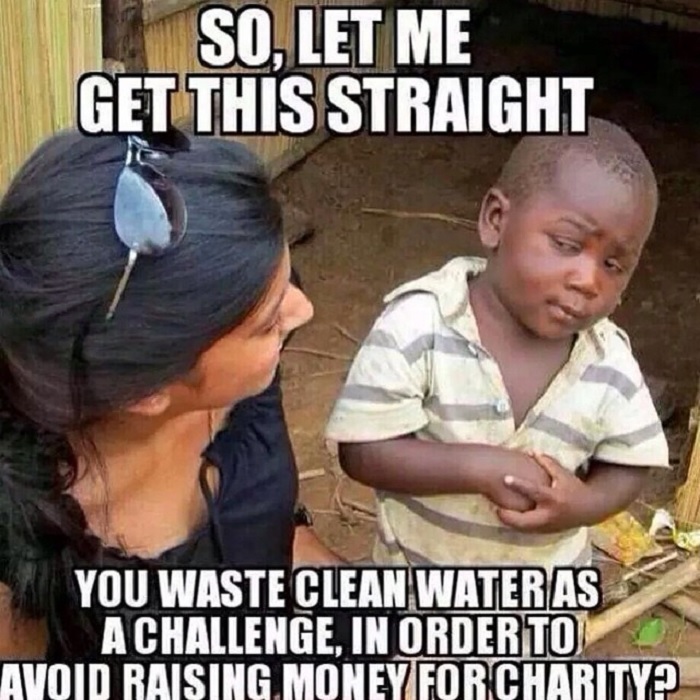America’s Funniest Home Fundraiser
A few weeks ago my friend Bruce asked me what I thought about the ALS Ice Bucket Challenge (hereafter called IBC). I recounted many of the dominant critiques. He pushed me, “Yeah, but what do you think?” My response: “It feels like an America’s Funniest Home Video approach to raising money and awareness.” What I meant is that there is a schadenfreude involved in watching these videos. I certainly laughed when Gayle dumped ice water on Oprah. It feels ok to laugh, because no one really got hurt. And it’s for a charity, so it makes people feel good. The phrasing struck a chord with my friend and as coverage of the campaign and debates around it have proliferated it seems to be an increasingly good lens for explaining why the IBC became viral. Moreover, I think it offers a useful starting point for understanding some of the core problems with using this type of humor to raise money.
There are, of course, many critiques of the ALS IBC. The most obvious one: you do not need to dump icy water on your head to donate money to a cause. Also critiqued: the rules of the challenge were originally that if you dump water on your head you actually do not donate money, but as this article demonstrates many people did both. The campaign raised an astounding amount of money for the ALS Association, but some claim that the campaign results in “funding cannibalism,” pulling potential donations away from other causes. This critique assumes that people would indeed donate elsewhere were they not donating to the ALS charity. As with any high profile non-profit, there were concerns over where money sent to the campaign actually goes; though further research indicates it is spent largely as advertised. Related to this, Catholic organizations have protested the challenge, claiming that the ALS Association funds stem cell research (though not embryonic stem cells as was claimed). Other critics have decried animal testing involved in ALS research.
 In addition to concerns over the money, the water in the buckets has been a major concern for critics of the campaign (one journalist even calculated how much water has been used so far). Many have critiqued the implications of wasting water in the fundraising campaign (see here for example). Water is a precious commodity and not universally accessible. Just focusing on the U.S., there is natural scarcity in the Western regions of the country (people in California are even being fined for participating in the IBC) and corporate-produced scarcity in Detroit. The challenge itself reportedly led to a water shortage on Colonsay Island in Scotland.
In addition to concerns over the money, the water in the buckets has been a major concern for critics of the campaign (one journalist even calculated how much water has been used so far). Many have critiqued the implications of wasting water in the fundraising campaign (see here for example). Water is a precious commodity and not universally accessible. Just focusing on the U.S., there is natural scarcity in the Western regions of the country (people in California are even being fined for participating in the IBC) and corporate-produced scarcity in Detroit. The challenge itself reportedly led to a water shortage on Colonsay Island in Scotland.
Moving from the utilitarian concerns of money and water, there is a group of reviews that focus on the effects of the IBC dominating mainstream discourse. The disconnect between online sharing of police brutality in Ferguson and Bucket challenge videos, for example, demonstrates the impact social network algorithms have on what information we see. Harsh critiques have been levied by several commentators against celebrities, particularly Black celebrities, who took part in the IBC but made no statements about the attacks on protestors in Ferguson (see here and here). These pieces often cite the fact ALS is a disease that primarily affects older, white men.
Most, but certainly not all, of these condemnations tend to disparage those making bucket videos as dupes or slacktivists. I can’t help but think of these critiques as a Frankfurt School approach, treating participants as passive recipients of the campaign’s message and ignorant of the deeper implications of their participation. As with media studies, this shaming of participants does not get us very far in understanding how the campaign taps into bigger cultural logics; it also isn’t really fair because it refuses to understand participants’ own reasons for making and posting videos. I think there are more interesting things to be said about this campaign. We can do this in part by looking at how people have reworked the IBC.
Some adaptations have focused on the water itself. Some Iranians, for example, made modifications to the bucket challenge given the scarcity of water in the region. In a nuanced critique of IBC actor Orlando Jones replaced water with bullets, highlighting a cause of death that disproportionality affects Black men in the U.S. Similarly, soldiers in Gaza replaced the ice water in the challenge with rubble, to raise awareness of living conditions in the region. Tying together the resource and ideological concerns, there is a campaign circulating to “hack the ice bucket challenge.” It relies on many of the same conventions of the ALS challenge, but encourages people to use their water responsibly and raising awareness of racism in America. The taco or beer challenge, started to raise awareness and funds for abortion-rights organizations, points out the absurdity of the connection between the challenge and the cause by offering a tastier alternative to dumping water on yourself.
The ways people have appropriated and redeployed the campaign tell us much more about how it “worked” than critiques of people who participated. In making more critically engaged videos, these hacks of the campaign have actually zeroed in on what it was that drew so many people to the campaigned in the first place: the prank. Buckets of bullets or rubble and standing in planters while outlining the global impact of structural racism aren’t funny (nor are they supposed to be). As the interviewee at the end of the BBC news segment on the bucket challenge in Iran says of the water-responsible approaches, “It’s not fun anymore.” The taco and beer challenge is funny, but not in the same way. It takes out the schadenfreude. This is why, while horrified, I was not that surprised by the attack on an autistic teen who thought he was going to be part of a IBC video. When altruism becomes enmeshed in laughing at the expense of others, we get a little more insight into what our culture values and promotes.



